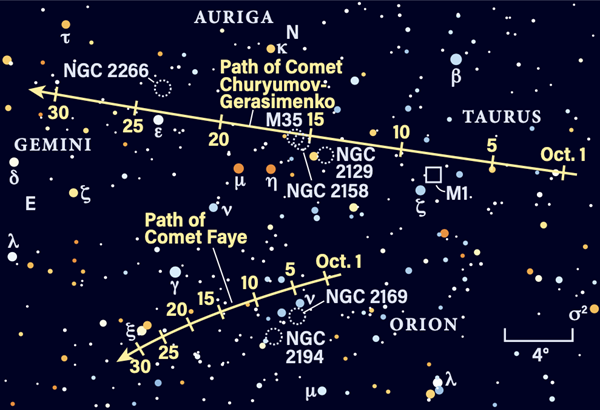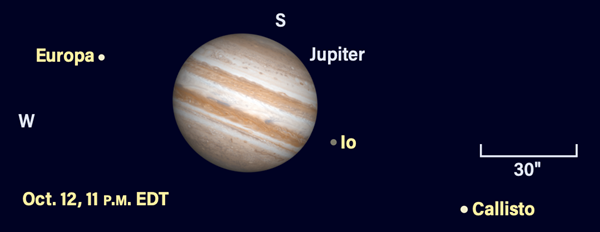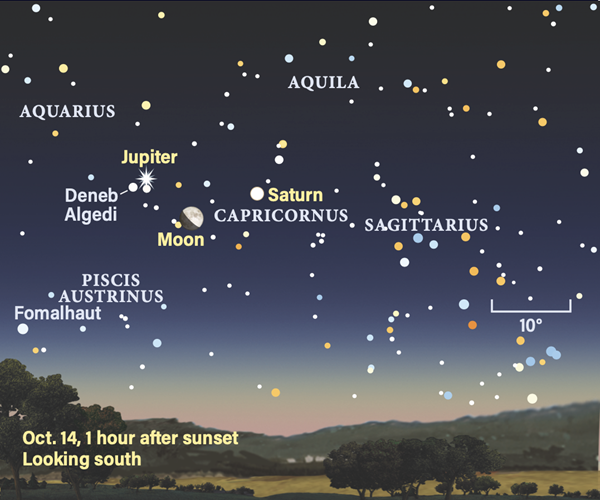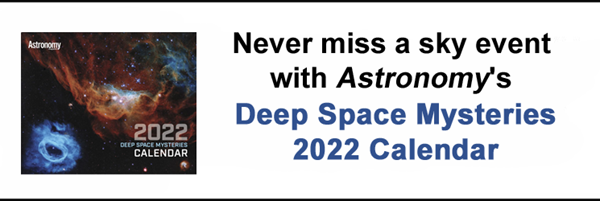Friday, October 8
Today, tomorrow, and Sunday, the Royal Astronomical Society (RAS) is hosting a public livestream of the planet Uranus, as observed with NASA’s Infrared Telescope Facility on Mauna Kea in Hawaii. The livestream will run each morning from 4 A.M. through 11:55 A.M. EDT on the RAS YouTube Channel. But these observations are more than just a chance to enjoy clear views of the ice giant — they will also be used to create the most detailed infrared map of the planet to date. Researchers hope to catch the planet’s southern aurora to chart and learn more about it.
If you want to find Uranus for yourself, it rises around 7:30 P.M. local time and will be well poised for observation in the east a few hours later. It’s approaching opposition, which it will reach next month. You’ll find it in the constellation Aries, where it’s an easy-to-spot magnitude 5.7 — potentially just visible with the naked eye from an extremely dark location. Binoculars or any small scope will pick it up no problem; look for Omicron (ο) Arietis, which shines just 0.1 magnitude fainter, and sits less than 12′ south-southwest of the planet tonight. Uranus will draw closer to the star over the coming nights and the two will sit less than 10′ apart by October 10.
The Moon reaches perigee — the nearest point to Earth in its orbit — at 1:28 P.M. EDT. At that time, it will stand 225,797 miles (363,385 kilometers) from our planet. A bit later, at 3 P.M. EDT, the dwarf planet 1 Ceres reaches its stationary point in Taurus.
Sunrise: 7:04 A.M.
Sunset: 6:30 P.M.
Moonrise: 9:34 A.M.
Moonset: 8:04 P.M.
Moon Phase: Waxing crescent (7%)
*Times for sunrise, sunset, moonrise, and moonset are given in local time from 40° N 90° W. The Moon’s illumination is given at 12 P.M. local time from the same location.
Saturday, October 9
Mercury reaches inferior conjunction at 12 P.M. EDT. This puts it essentially directly between the Sun and Earth, rendering the tiny planet invisible. But don’t worry — it will slip away from our star’s glare to reappear in the morning sky later this month.
Instead, try searching the early-morning skies for Comet 67P/Churyumov-Gerasimenko, which skims 1.2° northwest of the famous Crab Nebula (M1) in Taurus the Bull. The magnitude 8.4 supernova remnant lies directly between the comet and 3rd-magnitude Alheka (Zeta [ζ] Tauri), which marks one of the Bull’s horns. 67P is a 10th-magnitude fuzz about 6′ across; you should be able to get both it and the nebula in a single telescope field. Binoculars will show an even wider field of view.
While you’re here, follow the line from 67P through M1 and Alheka another 11° southeast and you’ll run smack dab into Comet 4P/Faye, which sits about 1.5° northeast of 4th-magnitude Xi (ξ) Orionis in Orion the Hunter. Faye is a bit fainter (magnitude 11) than Churyumov-Gerasimenko, but roughly the same diameter. It’s traveling southeast against the background stars, compared to Churyumov-Gerasimenko’s, more northeasterly path.
Sunrise: 7:05 A.M.
Sunset: 6:29 P.M.
Moonrise: 10:50 A.M.
Moonset: 8:43 P.M.
Moon Phase: Waxing crescent (14%)
Sunday, October 10
Saturn is stationary tonight at 10 P.M. EDT, when its retrograde motion against the backdrop of faraway stars halts. In the coming days, it will appear to swing around and begin moving eastward, although the motion will be hard to pick up by eye.
The solar system’s second-largest planet is currently located in Capricornus the Sea Goat; it’s rising in the south as the Sun sets and visible all evening, setting just before 1 A.M. local time. That makes the best time to view it around 8 P.M. local time, when it’s highest in the sky. Glowing at magnitude 0.5, it’s on the opposite side of the constellation from brighter Jupiter, which shines at magnitude –2.6. Saturn sits just below the midpoint of a line drawn between Theta (θ) and Beta (β) Capricorni.
Zoom in on the planet tonight and you’ll see that its two-faced moon Iapetus is also at superior conjunction. It now stands about 40″ north of Saturn and is roughly magnitude 11. Over the course of the month, it will dim to magnitude 12 as it approaches greatest elongation on the 29th. Several other moons float around the planet as well, including bright Titan 2.5′ to its southeast and dimmer Rhea, Tethys, Dione, and Enceladus closer to Saturn and its magnificent ring system.
Sunrise: 7:06 A.M.
Sunset: 6:27 P.M.
Moonrise: 12:07 P.M.
Moonset: 9:30 P.M.
Moon Phase: Waxing crescent (24%)
Monday, October 11
The Moon tonight sits just off the spout of Sagittarius’ Teapot asterism in the south. With a telescope, zoom in on the lunar north to find Mare Frigoris, an elongated sea draped over the larger, rounder Mare Imbrium and Mare Serenitas.
Just beneath Mare Frigoris is the 54-mile-wide (87 km) crater Aristoteles. To its immediate east is the small crater Mitchell, and southeast lies Exodus. Really zoom in on these craters to drink in their immense detail. Aristoteles has no central peak, but instead boasts several smaller mountaintops poking up from its flooded floor. Lighter-colored ejecta sprays off to the crater’s north. Next, look closely at the rim of Exodus to see if you can make out its numerous terraces. This crater, too, lacks a central peak; you’ll instead see a few low hills in the middle of its bowl.
Of course, just what you’ll see and how you will see it will change as the Sun’s angle also changes over the next few hours and days. You’ll want to return to this spot tomorrow and the day after to see how these features appears to morph as the Sun moves over the lunar landscape.
Sunrise: 7:07 A.M.
Sunset: 6:26 P.M.
Moonrise: 1:18 P.M.
Moonset: 10:25 P.M.
Moon Phase: Waxing crescent (34%)
Tuesday, October 12
First Quarter Moon occurs this evening at 11:25 P.M. EDT. Before then, though, you’ll already want to be focused on Capricornus, where there’s a show going on around brilliant Jupiter in the constellation’s northeast region.
If you’re able to catch the gas giant early enough, you’ll see it start out the night with all four moons: Callisto to the east and Io, Europa, and Ganymede to the west. Io disappears behind the planet’s western limb around 8:18 P.M. EDT, scooting behind the planet to reappear about three hours later.
But first, something strange happens. Look at Callisto, roughly 1′ from Jupiter’s eastern limb. Around 11:11 P.M. EDT, it begins to disappear, despite its apparent distance from the planet. That’s because it’s fallen into Jupiter’s long shadow, which stretches out far behind it. Even weirder, Io pops back into view at 11:43 — much closer to the planet (25″ east of the limb) than Callisto was when it disappeared! These effects are due to the geometry of the Jupiter system from our point of view.
Keep watching if you’re able, because Europa is now closing in from the west. The icy moon will slip behind Jupiter’s limb at 12:40 A.M. EDT on October 13 for those in the Eastern time zone.
Sunrise: 7:08 A.M.
Sunset: 6:24 P.M.
Moonrise: 2:20 P.M.
Moonset: 11:28 P.M.
Moon Phase: Waxing crescent (45%)
Wednesday, October 13
The Moon is growing more prominent in the sky, but that doesn’t mean all deep-sky observing must end. Perseus the Hero is home to several distant objects, including in the famous Double Cluster. Cataloged as both NGC 869 and NGC 884 and h and Chi (χ) Persei, these two open clusters sit just under 30′ apart. Together, they cover about twice the size of the Full Moon on the sky.
You’ll find this pair in northwestern Perseus, about 4.5° northwest of Miram (Eta [η] Persei). They’re relatively high in the northeast all evening and best viewed under low power. Both are roughly 4th magnitude and generally visible under dark skies as gray smudges. They’ll easily pop out in binoculars or a telescope, or even your finder scope. Their proximity is more than just a chance alignment, too — they’re actually close together in space as well, both about 7,600 light-years away. They were likely born from the same massive cloud of dust and gas, and are roughly 13 million years old.
Sunrise: 7:09 A.M.
Sunset: 6:23 P.M.
Moonrise: 3:12 P.M.
Moonset: —
Moon Phase: Waxing gibbous (56%)
Thursday, October 14
The Moon passes 4° south of Saturn at 3 A.M. EDT. Both are below the horizon at that time, so catch them instead this evening after sunset, now 9.5° apart. Our waxing satellite lies east of the ringed planet and southwest of Jupiter, which it will pass close by tomorrow morning. All three are in Capricornus, whose brightest stars trace out a rough sideways triangle on the sky. Its leftmost corner is the bright star Deneb Algedi, which glows at magnitude 2.9 and currently sits 2° southeast of bright Jupiter. The word deneb means “tail” in Arabic, which is why it is also associated with the bright stars that mark the tails of Cygnus the Swan and Cetus the Whale.
Deneb Algedi’s brightness varies regularly because it is in an eclipsing binary system. Every 24.55 hours, its companion star passes in front of it from our point of view, dimming Deneb Algedi by 0.2 magnitude. Sharp-eyed observers can tell the difference between its brightest and dimmest phases, particularly by comparing it to nearby stars. But Deneb Algedi is also intrinsically variable, changing its own brightness over time as it pulses. It is classified as a Delta Scuti variable, after the hallmark example in Scutum the Shield.
Sunrise: 7:10 A.M.
Sunset: 6:21 P.M.
Moonrise: 3:54 P.M.
Moonset: 12:36 A.M.
Moon Phase: Waxing gibbous (67%)
Friday, October 15
The Moon passes 4° south of Jupiter at 6 A.M. EDT — again, the pair isn’t visible at the time, but instead hang in the sky after sunset. They are now 8.2° apart and the Moon has moved into Aquarius, which borders Capricornus to the north and east.
Also in Aquarius is Neptune, the solar system’s most distant planet. Currently magnitude 7.7, binoculars or a small telescope should net you its 2″-wide, bluish disk. Tonight, the planet sits 3.5° east-northeast of 4th-magnitude Phi (ϕ) Aquarii. It will close that gap by just a bit to 3.2° by the end of the month.
The Moon will pass close to the giant planet on its trek across the ecliptic in just a few days, so stay tuned to this part of the sky through early next week.
Sunrise: 7:11 A.M.
Sunset: 6:20 P.M.
Moonrise: 4:28 P.M.
Moonset: 1:46 A.M.
Moon Phase: Waxing gibbous (77%)














